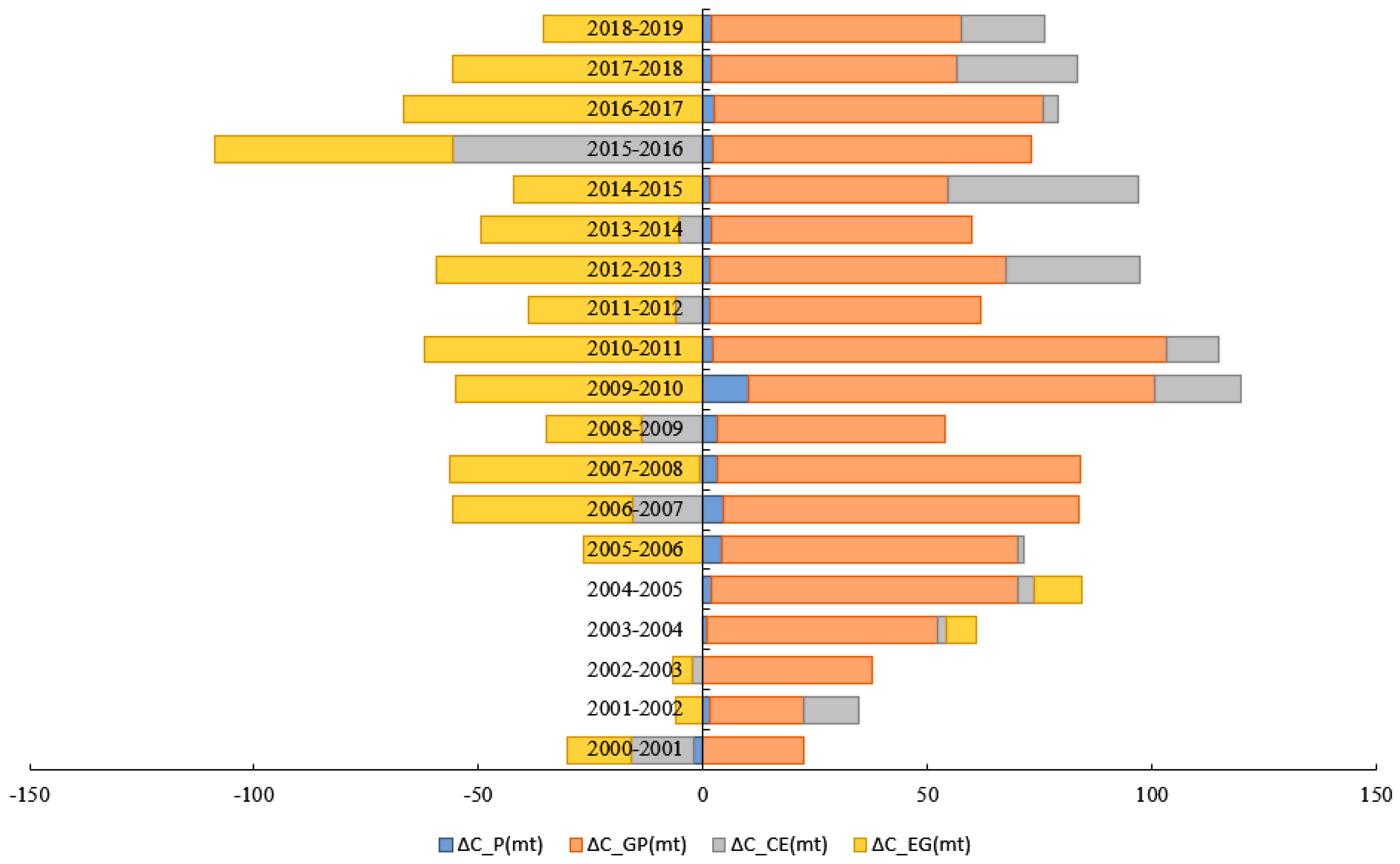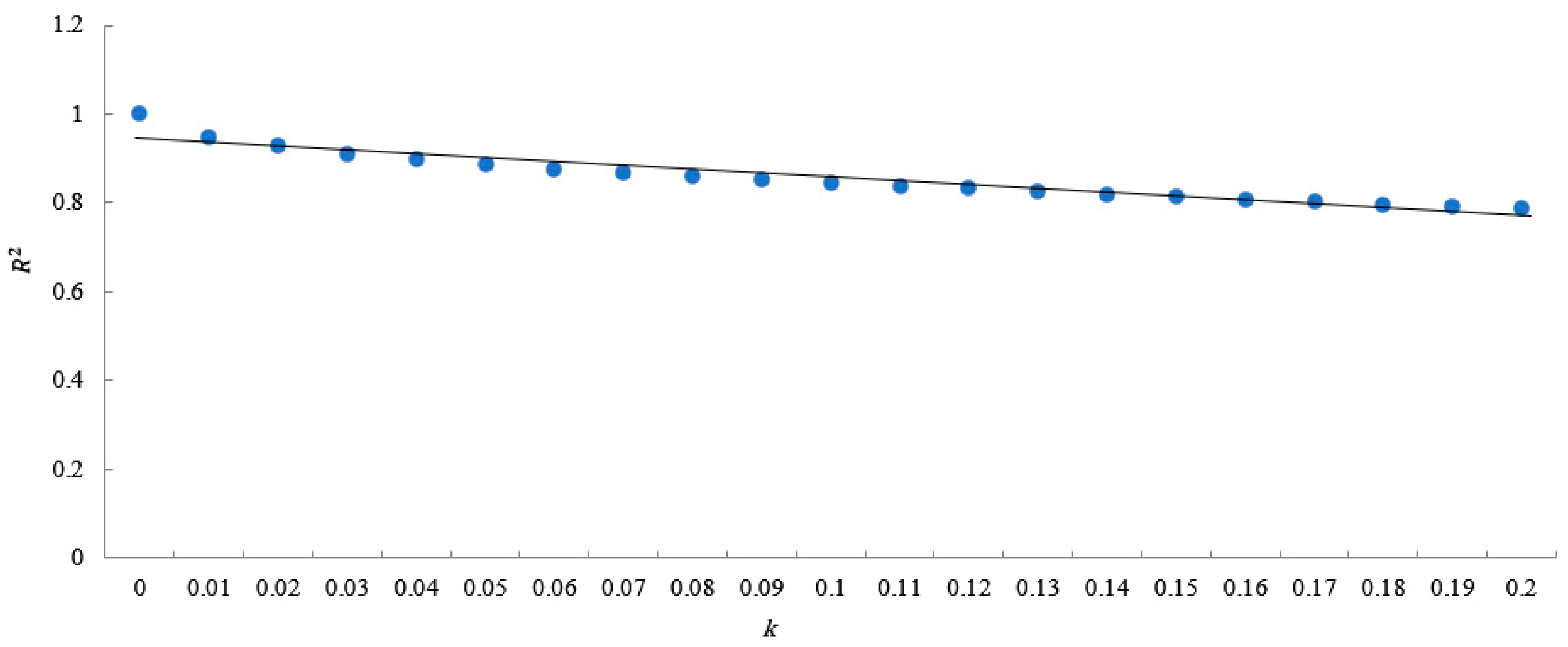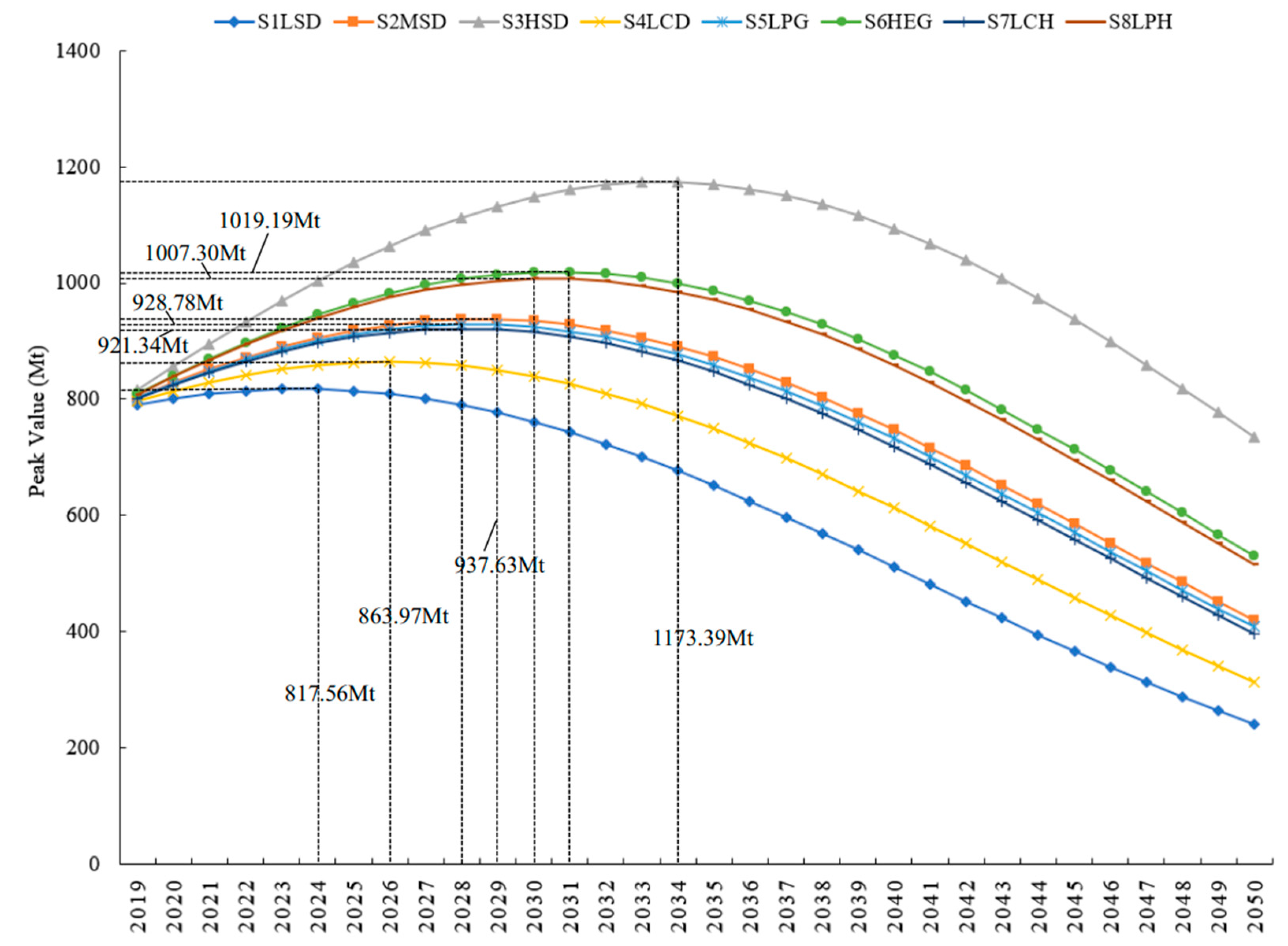1. Introduction
Climate change has been significantly impacted by greenhouse gas emissions and is a major obstacle to sustainable development around the world [
1,
2,
3]. In the last 50 years, global industrialization has accelerated significantly and carbon emissions have increased greatly, resulting in global warming. Global average temperature has risen by more than one degree Celsius since 1960. Therefore, controlling global warming by reducing carbon emissions has become an international consensus [
4,
5,
6].
In response, countries have taken various measures to reduce carbon dioxide emissions and actively combat climate change. As the world’s largest energy consumer, China attaches great importance to carbon emission reduction [
7]. At the 75th United Nations General Assembly in September 2020, President Xi Jinping stated that peak carbon should be achieved by 2030 and carbon neutrality should be achieved by 2060. Located along the eastern coast of China, Jiangsu Province has a developed economy and trade but also high carbon dioxide emissions. Carbon emissions from Jiangsu comprised 5.2% of the national total in 2019. Determining how to achieve the planned peak carbon and carbon neutrality tasks while ensuring steady economic and social development is a practical problem for Jiangsu Province [
8].
Therefore, the aim of this study is to develop a system for the analysis of influencing factors for carbon emissions in Jiangsu based on historical data and to use this system to make a prediction for future carbon emissions in Jiangsu. Its significance is to permit us to specifically extract the main factors that affect Jiangsu’s carbon emissions based on its own development characteristics, thereby improving the model’s fit and providing a higher confidence level for subsequent prediction results.
Over the past few years, the academic community has paid increasing attention to the issue of carbon emissions. Based on national data, many studies have analyzed and discussed China’s future peak carbon trend from different perspectives and there is optimism that China can achieve its peak carbon goal by 2030 as planned [
9,
10,
11,
12,
13,
14,
15,
16,
17,
18]. However, some studies believe that it will be challenging for China to achieve the established peak carbon goal. For instance, Chen et al. (2019) predicted that the Chinese carbon emission peak will not occur earlier than 2036, based on the Kuznets curves for four major industries: industry, construction, transportation, and agriculture [
19]. According to Liu et al. (2017), without additional policy interventions, China’s carbon dioxide emissions will increase until 2040 [
20]. Based on the Tapio decoupling model, Wu and Xu (2022) stated that China’s current carbon emission reduction efforts are not sufficient to achieve the 2030 peak carbon goal [
21].
As the provinces of China are at different stages of development, there are great differences in energy supply, energy consumption, and economic development models. Thus, some studies have combined the specific characteristics of different provinces to explore their energy consumption changes and carbon emission trends. Using data from 30 provinces, Jiang et al. (2017) systematically analyzed the contributions of relevant contributing factors to China’s increasing carbon emissions and concluded that, as China’s carbon dioxide emissions have increased, each province’s contribution has differed significantly over time and its driving mechanisms have changed dynamically [
22]. According to an analysis by Chong et al. (2017), the growth of the economy and population are the primary factors driving the growth of Guangdong’s energy consumption, whereas improvements in electrical supply efficiency are the primary inhibitors [
23]. Using a multiagent intertemporal optimization model, Pan et al. (2021) predicted the CO
2 emission trends of 13 main industries in Liaoning Province [
24]. Dong et al. (2021) investigated the factors that influence carbon emissions from 12 major industries in Henan Province [
25]. Li and Yang (2020) reclassified energy production in Shandong Province according to energy flow and consumption responsibility and proposed a new method for provincial carbon emission estimation [
26]. According to Li et al. (2021), carbon dioxide emissions from the construction industry in Jiangsu will only reach their peak in 2029 if three measures are taken: the encouragement of research and development investment, the promotion of the use of energy-efficient buildings, and carbon trading [
27].
In terms of the research methodology, there have been significant differences in the approaches taken to study carbon emissions. For instance, the stochastic impacts by regression on population, affluence, and technology (STIRPAT) model is mainly used for the future prediction of emissions [
28,
29,
30], the logarithmic mean Divisia index (LMDI) method concentrates on the decomposition of the factors driving carbon dioxide output [
31,
32], the Grey model can be used to estimate future carbon dioxide emission intensity [
33,
34], and the multi-objective optimization approach can be used to adjust and optimize carbon emission strategies [
35,
36]. Some studies have used a combination of various methods to analyze specific problems associated with carbon dioxide emissions [
37,
38,
39,
40,
41,
42].
This study contributes to previous studies in two respects. First, the influencing factors of carbon emissions in Jiangsu are decomposing based on the actual situation and characteristics of Jiangsu. In accordance with to the previous studies, the factors that affect carbon emissions in China and in certain provinces are discussed. However, due to significant differences in resource endowments and development levels among provinces across the country, the influencing factors of carbon emissions in different provinces are also different. Therefore, it is necessary to conduct specific analysis of the main influencing factors of carbon emissions in Jiangsu Province. Second, based on the STIRPAT model, the future carbon emissions of Jiangsu are predicted. Numerous studies have been conducted on the prediction of carbon emission peaks at the national level in China and many believe that the country will meet its peak peak carbon target on schedule. However, there is little discussion on whether Jiangsu can achieve this peak carbon target. As China’s economic powerhouse and major industrial province, Jiangsu has attracted attention from all walks of life regarding its potential to achieve its peak carbon goal on schedule while ensuring its own economic development speed is maintained. Predicting the future carbon emissions of Jiangsu under different scenarios based on the STIRPAT model can just make up for the lack of existing research.
4. Conclusions and Policy Implications
4.1. Conclusions
In this study, we employed the LMDI method to investigate Jiangsu’s carbon emissions from 2000 to 2019. In addition, an expanded STIRPAT model was developed to evaluate the influences of four key factors (population size, economic output, energy intensity, and energy structure) on Jiangsu’s carbon dioxide emissions from 2000 to 2019. On this basis, eight scenarios were constructed to evaluate future emissions in Jiangsu. The main findings of this study are that energy intensity has a mitigating effect on carbon emissions and that it would be possible for Jiangsu to reach peak carbon by 2024 with S1LSD. The following conclusions can be drawn:
(1) Jiangsu’s carbon emissions have been growing since 2000–2001; however, its growth rate has been declining on a yearly basis. Among the influencing factors, energy intensity has shown a mitigating effect by accumulating carbon dioxide emissions of −658.38 Mt over 20 years. Population size, economic output, and energy structure all have deleterious effects on carbon emissions, leading to the production of 45.16 Mt, 1159.97 Mt, and 58.45 Mt of carbon emissions, respectively, over the past 20 years.
(2) According to the scenario analysis results, under S1LSD, S2MSD, S4LCD, S5LPG, S7LCH, and S8LPH, it will be possible for Jiangsu to achieve peak carbon by 2030. Among these, S1LSD is associated with the earliest peak carbon time of 2024. The peak value of the above six scenarios is 817.56 Mt–1007.30 Mt.
(3) With S4LCD and S7LCH, it is predicted that peak carbon will be achieved in 2026 and 2028, respectively. With both of these scenarios, peak carbon value can be controlled within 925 Mt and both are consistent with Jiangsu’s current development and the policy orientation of future low carbon development. Therefore, both are more desirable choices.
4.2. Policy Implications
(1) The development of economic and social activities should be coordinated and greenhouse gas emissions should be reduced. Economic and social development are strongly correlated with carbon emissions. Attempting to place a peak carbon goal in an important position while ignoring regional economic development and social development or continuing to promote the original extensive economic development model while ignoring the “double carbon” constraint is not recommended. It is necessary to further explore the deep connections between Jiangsu’s population, economy, energy consumption, and other factors with carbon emissions and to determine a balance point between economic and social operations as well as the reduction of emissions in order to smoothly achieve the “double carbon” goal and to allow the comprehensive and sustainable development of the region’s economy and society.
(2) The transformation and upgrading of energy structure should be accelerated by taking advantage of the “dual carbon” development opportunity. Jiangsu has been driving regional economic and social development for a long time through high investment and high growth, but this has caused pollution and ecological damage in the region for many years. Therefore, Jiangsu needs to take advantage of the “double carbon” development opportunity by utilizing a combination of advantages encompassing industry, capital, technology, research, and development; implementing inventory management and classified disposal measures; and accelerating the low-carbon transformation of energy-consuming and high-polluting enterprises. In addition, Jiangsu could increase the development and utilization efficiency of new energy by building green industrial clusters. Furthermore, Jiangsu should continue to increase its investment in the research and development of low-carbon technologies; promote the research and development of carbon sinks, carbon capture, and other negative emission technologies; and accelerate the transformation and upgrading of the regional energy structure.
(3) Regionally-differentiated carbon emission reduction policies should be developed. First, there are significant differences in the physical geography, cultural conditions, economic development level, and industrial types of the cities in Jiangsu. When formulating carbon emission reduction policies, specific problems must be analyzed and differentiated low-carbon development strategies should be formulated according to the different characteristics and development stages of each city. Second, there are significant differences between cities and rural areas in terms of economic development, carbon dioxide emissions, and energy consumption. The government should develop targeted differentiation policies that reduce carbon dioxide emissions based on the actual situations of cities and villages.
This study still has limitations. First, the scenario analysis method can only reflect the future development trend of carbon emissions under different policies but cannot accurately estimate future carbon emissions. Further studies should attempt to compensate for these shortcomings by using quantitative analyses. Second, this study is only based on the current situation of Jiangsu Province. If similar methods are used to study peak carbon in other provinces, interprovincial differences should be considered. Third, this paper only selects the basic factors affecting carbon emissions. In order to make the prediction results more comprehensive and accurate, the basic influencing factors of carbon emissions can be further subdivided in subsequent research, and the selection range of influencing factors can be appropriately expanded.











